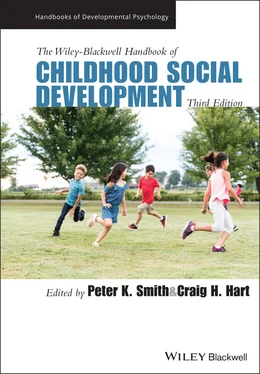Adopting an ecological perspective to bullying requires intervention approaches designed to address the complex multilayered influences. Interventions need to target multiple levels of risk and protective factors in the ecological system and involve school and communities in prevention efforts (Espelage et al., 2013). Divecha and Brackett (2020) argue that prevention needs more than just school‐level action, and they set out a tiered approach targeting each layer of the ecological system. It seems then that current thinking within the field is drawing on ecological perspectives as a way of understanding, preventing, and managing bullying, and it offers much potential to help contextualize a very complex problem.
Implications for Research and Intervention
It is hopefully apparent from the material discussed in the previous sections that ecological perspectives have a lot to offer in our understanding of social development. First, they enable us to recognize the complexity of factors that contribute to social development. This moves attention away from focusing purely on individual characteristics (such as biology and personality) to also considering influential factors in the social context children are part of. Second, ecological perspectives encourage us to consider intersecting components of social development rather than viewing them in isolation. For example, we have seen in the examples discussed in this chapter that experiences in one area of social development (such as parenting) can influence those in another (such as bullying) and vice versa. Development is fluid, dynamic, and needs to be viewed holistically. Third, ecological perspectives suggest we should be wary of making assumptions about the universality of developmental stages or processes. Our understandings of social development need to be sensitive to social and cultural variation rather than generalizing to all children and young people.
A challenge of adopting an ecological lens to social development is designing empirical research that effectively captures the complex interplay between person and environment, and that enables contextual factors to be explored. Elder’s previously mentioned research into the Great Depression (1974) adopted a longitudinal approach to examine changes over time and study the trajectories of development across different times and places. This enabled an in‐depth study of the life course, and influences that occurred at different stages. Studies like this can be immensely powerful in highlighting the value of ecological perspectives in understanding human experiences but may not always be feasible given limited resources and practical considerations.
Recent literature in the domains of social development examined in this chapter show the potential for other research approaches utilizing quantitative and qualitative techniques. For example, Hong et al. (2018) used a large‐scale survey to measure the correlates of cyberbullying in South Korean adolescents. Parts of the survey were designed to measure factors in different layers of Bronfenbrenner’s ecological system, including questions relating to individual variables (such as age, gender), family factors (such as parental abuse and neglect), peer relationships, school factors (such as connectedness, teacher abuse), neighborhood safety, and economic hardship. Such techniques are useful to enable many ecological influences to be measured within a single study and illustrate how ecological perspectives can be applied as an explanatory model in large samples. However, the practicality of measuring multiple elements within a survey meant that some factors were only measured via a single item and were based on self‐report. This limits the applicability of the method to children with lower literacy levels and means that the complexity of individual experience is not captured.
As an alternative, in the field of parenting, Singh and Naicker (2019) used in‐depth qualitative interviews with sample of teenage mothers (16–18 years old) from secondary schools in a specific region in South Africa where there were conditions of economic deprivation and unemployment. Nuanced insight into their experiences was gained through their accounts, seeing how they built resilience in the context of surrounding cultural norms and adverse social conditions. Nevertheless, the findings are tightly bound to the study setting, and dependent on appropriate access and strong participant–researcher relationships.
This shows that there is the potential for researchers to draw on different methodologies when studying ecological factors. It is too straightforward to prioritize one methodological approach over another as they can each provide valuable insight in particular situations. Importantly, the research needs to be socially relevant in order to effectively capture the person–environment interaction. Research needs to take a holistic view which accounts for the constellation of influences on individuals, rather than research on individual factors undertaken in silos (Patton et al., 2013). There is also the opportunity for ecological perspectives to be used as a tool for integrating and adding an interpretive frame to a body of empirical research in a field. This can be seen in several papers about bullying, where ecological perspectives were applied to understand findings from existing literature in order to make a theoretical argument (see Hong & Espelage, 2012; Hong et al., 2014a, 2014b).
In addition to research implications, there are implications for professional practice arising from ecological perspectives. When working with children and young people, ecological perspectives can inform the way we conceptualize their social experiences, and design interventions to support identified social difficulties or problems. An example of this is through case formulation, which is a technique used to making sense of the problems people are experiencing and the reasons for these (Johnstone & Dallos, 2014). Case formulation is a fundamental skill for practicing psychologists, and the processes and skills involved in doing this effectively form a central feature of professional training for areas such as clinical and educational psychology.
Although various approaches to formulation place differing emphasis on the role of context and degree of attention on wider influences (Johnstone & Dallos, 2014), the overarching process underpinning formulation takes into account an individual’s relationships and social contexts in seeking to formulate hypotheses for the problems they are experiencing. In this vein, practitioners are encouraged to attend to individual factors, and the system outside the individual that exerts an influence on their life (such as family, school, and work) (Weerasekera, 1993). The individual is seen as being part of a system of complex relations, and in order to understand a particular situation, problem, or presenting issue there is a need to cast the lens wider. Although not explicitly framed as an ecological approach, this attention to systems certainly aligns to ecological thinking.
Similarly, professional guidance for trainee educational psychologists promotes circular causality, whereby the cause of a difficulty should not be seen as within the individual, it is a result of the functioning of the system as a whole (Beaver, 2011). This turns attention away from problem‐focused strategies which position the child as the one with the deficit, who is to blame for their situation and who, therefore, needs to change. Psychologists need to look at the wider systems around the child (such as family, school, and other influences) and identify opportunities for change there (Beaver, 2011). As a result, interventions for social difficulties or problems in social development that children and young people might experience should be suitably designed to accommodate this. Approaches that operate entirely at the individual level are likely to be less effective than those which also involve other key influences in a child’s life. Interventions should, therefore, reflect the person–environment interplay that gave rise to the situation and seek to make change at multiple levels. Multifaceted interventions would be recommended, involving different parts of the ecological system.
Читать дальше












